vintage cameras index home

Argus Model M – Designer: Gustave Fassin

Barndoors and two frame windows gave half-frame capability.

Argus Model M and Delco 828


Pre-war graphics

35mm film can be used without backing paper
Two factors contributed to the early demise of the Model M. The first was a temporary setback. Kodak stopped producing 828 roll film during the war, leaving buyers with little film available to feed the 828-format cameras. More importantly, perhaps, the imagination of the camera buying public had been captured by the idea of 35mm cartridge and the cameras that used that format which were offered with a large number of available features including fast lenses, high-speed shutters, coupled rangefinders, and a normal film capacity as high as 36 frames per roll.
The little Model M could produce a negative exactly the same size as the larger 35mm cameras, but that only gave eight full-frame exposures on a roll of Kodak paper-backed 828. (Doors on either side of the frame could be flipped in to yield twice the number of half-frame exposures.) The Anastigmat Triplet lens was of very good quality, but had a maximum aperture of only f-6.3, and the simple shutter was limited to a single instant speed of about one-thirtieth of a second and a Time setting. Even with this limited feature set the construction was probably a little too complicated to meet the $7.50 price point the company was looking for with the Model M.
After WWII when 828 roll film again became widely available, Argus decided to further simplify the construction of the basic Model M design by replacing the collapsible lens with a fixed barrel, and the three element lens gave way to a two-element design. The half-frame capability was also eliminated. The resulting hybrid was sold by Argus from 1947 to 1949 under two names: the Model 19 and the Minca 28. The problem with those design decisions was that they threw the little Argus 828 camera into a large pool of cheap, small-format cameras. Argus ultimately sold the production dies for their 828 camera to a Philadelphia company and it remained on the market for a few years under the names Delco 828 and Camro 28.
There is a curious fact about the Argus Model M that provides some insight into its original design and possibly into the ultimate market failure of the camera. That is the dimesions of the negative which, as mentioned above, is identical to the standard 35mm frame. Kodak's 828 roll film is the same width as 35mm film, but the roll film does not have the double row of sprocket holes, meaning that the full 828 frame would normally offer about 30 percent greater negative area than 35mm. So, why did Argus decide to give up a substantial portion of that available film area using a smaller 35mm-size frame and thereby sacrifice some image quality?
The answer to the frame size mystery can be found in 1939 magazine ads for the Model M. In those ads we find that the Model M is built to use "...new 35mm. Arguspan film or specially spooled Dufaycolor film for natural color shots." It is not surprising that Argus would avoid promoting the 828 Kodak film which would fit in its camera and instead tout two brands made by other companies with which it had marketing agreements. What is most interesting, though, is that the film recommended by Argus is specified to be "35mm". Arguspan may have been actually produced by Ansco prior to the war; it yielded 12 exposures per roll and cost 35 cents. Dufaycolor, produced first in France and later in England, was orginally marketed primarily as a motion picture film and most probably had the same continuous borders of sprocket holes as any other standard 35 mm film. So, the Model M was designed from the beginning to use paper-backed 35mm film with sprocket hole borders which dictated a narrower frame width than standard 828 roll film. Furthermore, the supply of Dufaycolor was likely drying up by the mid-1940s as it was superseded by the more advanced color film processes embodied in Kodachrome and Technicolor. So the Argus gamble to take advantage of an alternative film supply in the end turned out to be a bad bet for the future of the little Argus M.
Aside from a missing Argus logo, my Model M looks nearly perfect, but it turned out to have some problems. The pictures from the first roll were all out of focus, and the negatives were riddled with light leak streaks. I disassembled the camera and found that the spongy packing in the collapsible lens mount was deteriorated and loose. The packing material was both letting some light by, and it also prevented the lens from fully extending to the proper focal length. I removed the lens mount packing material, reassembled the camera and loaded up another roll of Kentmere 100. The extended mount seemed to be making a good seal, but I layed on some black tape just in case. The second roll of film I put through the camera showed no light leaks or focus problems, and my expectations for the Anastigmat triplet lens were fully met. The images produced by the properly functioning camera were sharp from edge to edge. There is a small amount of vignetting in the corners of full-frame pictures, but I believe that is not from a lens fault, but rather from the shadow of the large coil spring which holds the lens mount in the extended position.
A useful lesson I learned from using the Model M is that it is possible to use 35mm film in 828 cameras without backing paper. I cut a tab on the 35mm film end and then rolled the film onto the little 828 reels and put it in the camera, making sure that it was advancing properly. Of course this must all be done in a dark bag, and the framing windows on the camera's back must first be covered with black tape. When attempting this for the first time, it seemed like there was a small chance of success due to the springy nature of the film. However, both rolls of film I've shot so far in the camera went through without a hitch, and one can get twice the number of frames from a single film loading than the camera was originally intended to produce.
I've since found that simply taping the squared ends of the 35mm film to the 828 reels gives better results.
Images from the Argus Model M (click to enlarge)

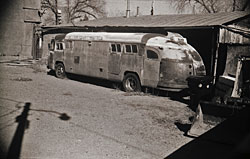
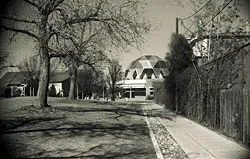
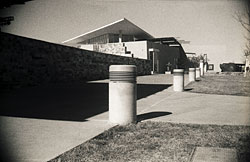
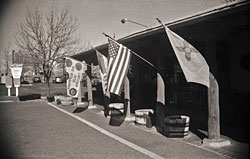
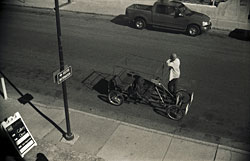
vintage cameras index home
 © mike connealy
© mike connealy